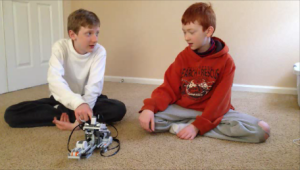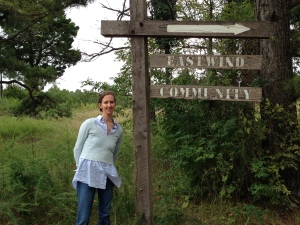First published January 21, 2015
 2014 was a busy year for my practice. It involved a great deal of outward, physical activity, including NLRBE-related travel and an NLRBE-related, family self-sufficiency experiment.
2014 was a busy year for my practice. It involved a great deal of outward, physical activity, including NLRBE-related travel and an NLRBE-related, family self-sufficiency experiment.
I expect 2015 to be different. I am currently leaning towards less frenetic NLRBE-related explorations.
Why?
|
*Important Reminder* |
I began 2014 still in recovery mode, after the discoveries I had made in late 2013. As you may know, in 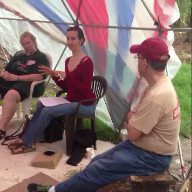 late 2013 I researched and spoke about legal options for creating NLRBE-like, egalitarian intentional communities, at the Twin Oaks Communities Conference. You can read about that here.
late 2013 I researched and spoke about legal options for creating NLRBE-like, egalitarian intentional communities, at the Twin Oaks Communities Conference. You can read about that here.
The research left me a bit discouraged and even scared about some of the complications and risks I saw with families like mine joining such communities. You can read about some of those concerns in the handout I passed around at that conference.
So, having begun 2014 a bit traumatized by what I had discovered, I felt inclined to turn inward.
Specifically, I began to experiment with the idea of focusing on my nuclear family as a miniature community. What if we could grow all or most of our own food, for example? What if we could promote an NLRBE by engaging in more gift economics at home and removing some of our support of the monetary system that way?
So, 2014 began with our family diving knee-deep into intensive home gardening. We had never much gardened before. And we went “all in” (which mostly involved me, as it turned out).
We figured, if we weren’t goin g to take it to the limit, why bother? We weren’t running this experiment to start a new hobby. Rather, we wanted to see if our whole family could come together to eventually live primarily off of our own food cultivation efforts. If nothing else, we figured we would learn something by running a full-tilt experiment to test the idea.
g to take it to the limit, why bother? We weren’t running this experiment to start a new hobby. Rather, we wanted to see if our whole family could come together to eventually live primarily off of our own food cultivation efforts. If nothing else, we figured we would learn something by running a full-tilt experiment to test the idea.
And learn something we did – many somethings, in fact.
Here’s what we learned, by the time all was said and done. (BTW, all was said and done only about two weeks go. It’s only been that long since the last of the season’s plantings officially died off and we made them into mulch. So, this is only about the second week in which we’ve been completely free of gardening for almost a year!)
Anyway, here were some of our key 2014 food self-sufficiency related discoveries:
- Growing your own food takes a lot of time. There may come a time where household robots and other forms of small-scale automation might make that less true (e.g., the up-and-coming, open source “FarmBot,”
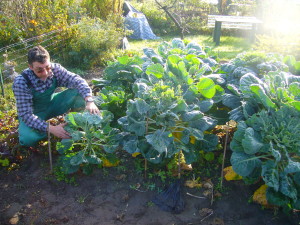
Picture of exhausted looking home gardener.
(NOTE: This picture is licensed for my use,
as I found it within the “Clipart”
collection of my Microsoft Office suite,
but do not consider it openly licensed,
as the rest of my article is, because I
have no rights to transfer the copyright.)combined with small-scale harvesting automation). Until then, it remains an incredibly time-consuming endeavor for most of us.
- It takes a lot to make it pencil financially as well. In our case we lost money, all told. Over a period of years we might have begun to shift that, by working our fingers to the bone. But even then, the net hourly effective earnings would fall well short of what my husband and I earn in our professions. This means way more work for a given quantity of home grown food, compared with the same quantity of purchased food.
- Granted, our home-grown food would arguably be more “valuable” in that it may be more “secure.” But to opt for the level of misery we experienced this last year, henceforth, in a quest for ultimate food security, does not seem worth it to us. Given the downsides to growing our own food, our food insecurity fears are sufficiently assuaged by now knowing that we could grow our own food if we had to. But our first choice, in the case of financial collapse, would be to put our all into more community-wide survival efforts, so that we would (all) have a better chance at not just surviving, but thriving.

Working together we can do more.
(NOTE: This picture is licensed for my use, as I found it within the “Clipart”
collection of my Microsoft Office suite, but do not consider it openly licensed,
as the rest of my article is, because I have no rights to transfer the copyright.)
- Related to the foregoing, I love how much more we can accomplish when we divide our labor as a species, rather than each try to do it all. The NLRBE vision completely embraces interdependence and divided labor (albeit divided amongst machine automated labor, whenever possible, and volunteer human labor, whenever necessary or desired). It’s the monetary system used for trying to coordinate and accomplish this interdependence that is so problematic, in ways discussed here and here.
- The more people (and automated alternatives) with whom we can divide our labor, arguably the more we can accomplish as a species. As a species, we can not only feed ourselves, but study and travel to other planets, discover cures to diseases, and create ever more advanced technologies to give humans ever increasing choice about how they spend their time. At the other extreme, trying to do it all individually, we can accomplish immensely less. In the middle, dividing labor only amongst members of a hundred person intentional community, let’s say, we could accomplish more than as individuals, but still nowhere near what we could accomplish as a species. For me, this has been a very sobering re-discovery. It makes intentional communities look more attractive then family self-sufficiency, but less attractive than working within the largest economy possible.
- Our 2014 intentional community visits led us to the same re-discovery about the value of maximally divided labor and large economies. For more details, click here.
- It turns out that my kids aren’t interested in subsistence farming/living, like so many youth in developing and developed countries alike.
Like so many humans generally, they strive to climb Maslow’s “hierarchy of needs.” They long to self-actualize. For them this means working on the cutting edge of what’s possible for humanity. They want to use, explore, and create fascinating, new, high tech things – things that are, at least currently, only possible with the focus that divided labor provides.
- Another discovery we made was that my husband and I don’t much enjoy subsistence farming/living either. Although I was doing most the work, he was regularly involved on weekends. And he, like the kids and I, found the work amounted to stressful, extra “to do” items. And, for me, very isolating ones, because I was doing the work alone the vast majority of the time.
- Perhaps if we had all been simultaneously passionate about doing a
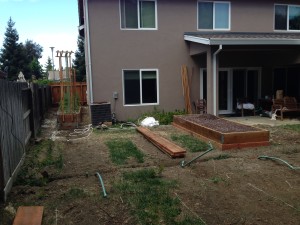 nd available to do the work, together, we would have found it fun and connecting enough to be sufficiently self-actualizing – or at least some people could have. It’s hard to be sure. But, in fact, we weren’t, and we didn’t.
nd available to do the work, together, we would have found it fun and connecting enough to be sufficiently self-actualizing – or at least some people could have. It’s hard to be sure. But, in fact, we weren’t, and we didn’t.
- In sum, we realized that we don’t want to work as hard as we worked last year, and, in the process, accomplish little more than stressing ourselves out, pretty well destroying our yard (pictured to the right), and depriving our local Sacramento Natural Foods Coop members, workers, and local farmer suppliers part of their basic income.
None of the foregoing is to say th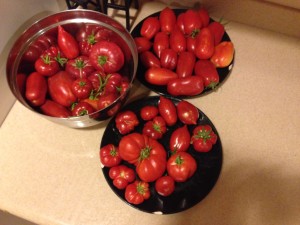 at there weren’t some delicious moments communing with nature and with each other, as well as some incredibly delicious tomatoes along the way. There were. 😉
at there weren’t some delicious moments communing with nature and with each other, as well as some incredibly delicious tomatoes along the way. There were. 😉
Yet, all in all, considering all the opportunity and financial costs, we cannot honestly say it would be an experiment worth repeating.
But we didn’t draw all of these stark conclusions until very recently.
By late April, 2014, we had only just become aware of some of the downsides listed above. You can get a sense of how optimistic I still was, and of my slowly dawning concerns, by checking out this blog post of mine, from around that time.
So, around April 2014, our family planned to both continue the gardening experiment through to the end of the season, and simultaneously explore intentional community possibilities further (the latter because of our slowly growing concerns about family self-sufficiency as a viable approach).
Specifically, we planned and took a two-week trip to Missouri. We went to see several intentional communities and Open Source Ecology, in September of 2014. You can read all about the discoveries we made on that intense, busy, amazing, overwhelming, trip here.
Almost as soon as that was over, I was planning for our next trip. This one was more local, but still fairly involved.
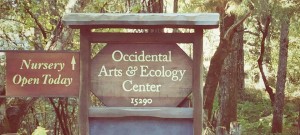
NOTE: Picture taken by friend, who permitted
me to use it. Please assume it is not okay to pass along.
Specifically, we spent a week in Occidental, California, where I attended Occidental Arts and Ecology Center’s five-day workshop on “Starting and Sustaining Intentional Communities,” in late October, 2014. I had hoped to finish and publish the blog post series, on what I learned at that workshop, by the end of 2014. However I have not quite yet put the finishing touches on it. I envision publishing it within a month or so.
After all of the foregoing, I found I felt pretty overwhelmed about how we had been exploring the NLRBE-like intentional community idea. Nowhere near as overwhelmed as I was at the beginning of 2014, and certainly not thinking of giving up on the idea. Just wanting to explore the idea in less physically busy, taxing ways this year.
So, all that said, here’s where I stand now, and what I see for 2015:
- What I/we won’t be doing:
- Not surprisingly, we are definitely going to take a break from the intensive, family self-sufficienc
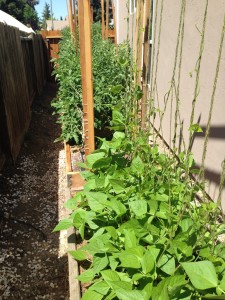 y approach to promoting an NLRBE. In particular, we plan on doing no home food growing whatsoever this year! (Although my husband talks about planting at least a few purchased tomato plants, he knows that would be his project, as he’s not quite as burnt out as I am 😉 .) I feel utterly ecstatic thinking about the opportunity costs we will be able to avoid with this choice! It is truly amazing to think of how much more restful and spacious a year we could have by just completely setting this to the side. How many more alternative opportunities could thereby become doable. I feel so excited to realize that it is nothing more than a simple choice we can make to completely avoid a repeat of that experience.
y approach to promoting an NLRBE. In particular, we plan on doing no home food growing whatsoever this year! (Although my husband talks about planting at least a few purchased tomato plants, he knows that would be his project, as he’s not quite as burnt out as I am 😉 .) I feel utterly ecstatic thinking about the opportunity costs we will be able to avoid with this choice! It is truly amazing to think of how much more restful and spacious a year we could have by just completely setting this to the side. How many more alternative opportunities could thereby become doable. I feel so excited to realize that it is nothing more than a simple choice we can make to completely avoid a repeat of that experience. - We are also planning to take a break from far-flung intentional community visits this
 year. Not because we have given up on either starting an NLRBE-like intentional community, or sharing how to do that with you all. Not at all. Rather, we’ll take the break for financial reasons, and to allow more spaciousness to explore aspects of the NLRBE-like intentional community idea through other, more manageable means. Prior to realizing our financial limitations this year, we had planned to visit Twin Oaks and Acorn again in 2015, as well as visit the Farm for the first time. However, upon further reflection, we realized that skipping the travel this year would not only save us needed funds, but would provide yet another large chunk of additional time and opportunities to explore the NLRBE-like community proposition from other vantage points.
year. Not because we have given up on either starting an NLRBE-like intentional community, or sharing how to do that with you all. Not at all. Rather, we’ll take the break for financial reasons, and to allow more spaciousness to explore aspects of the NLRBE-like intentional community idea through other, more manageable means. Prior to realizing our financial limitations this year, we had planned to visit Twin Oaks and Acorn again in 2015, as well as visit the Farm for the first time. However, upon further reflection, we realized that skipping the travel this year would not only save us needed funds, but would provide yet another large chunk of additional time and opportunities to explore the NLRBE-like community proposition from other vantage points.
- Not surprisingly, we are definitely going to take a break from the intensive, family self-sufficienc
- What we/I will likely be doing:
- Finishing and publishing my blog post series about OAEC’s workshop “Starting and Sustaining Intentional Communities.” Again, I envision doing that within the next month or so.
- Researching and publishing on other legal and related aspects of creating NLRBE-like intentional communities.
- Visiting and writing about other, local intentional communities, such as the newly starting, local, Fair Oaks Eco-Housing community.
- Helping our sons experiment with transforming their passions into a potential egalitarian community,
 eco-friendly, “pay what you can,” open source friendly, Creative Commons friendly, NLRBE-like “business” – and sharing what I learn along the way with you all! We already do interest-led homeschooling, so we’re half-way there in many respects. And we are all pretty excited about the idea. We’ve even rearranged our house in part to allow us to accommodate the possibility, first as a hobby, then possibly as a home/family business, then possibly beyond. We also rearranged our house to be more physically proximate to one another and interactive throughout the day. I’m especially excited about transforming all the time I spent alone in the garden into time spent co-creating a future that our boys may actually want to participate in! They’re older now and quite enjoyable to be with. There’s a lot more I could, and likely will say about this, going forward. But I’ll leave it there for now.
eco-friendly, “pay what you can,” open source friendly, Creative Commons friendly, NLRBE-like “business” – and sharing what I learn along the way with you all! We already do interest-led homeschooling, so we’re half-way there in many respects. And we are all pretty excited about the idea. We’ve even rearranged our house in part to allow us to accommodate the possibility, first as a hobby, then possibly as a home/family business, then possibly beyond. We also rearranged our house to be more physically proximate to one another and interactive throughout the day. I’m especially excited about transforming all the time I spent alone in the garden into time spent co-creating a future that our boys may actually want to participate in! They’re older now and quite enjoyable to be with. There’s a lot more I could, and likely will say about this, going forward. But I’ll leave it there for now.
So, all in all, I’m pretty excited about the year to come!
“Mixing it up” and “experimenting” seems to have accelerated our learning about how to best live and promote an NLRBE. For example, the decision to drop everything and try to grow most of our own food taught us numerous, priceless lessons that I have a hunch we could not have learned by just continuing on with the status quo. Likewise, hopefully the change in focus we’re planning for this year, compared with last, will offer similarly accelerated learning opportunities.
So, bring on the latest experiment! I am grateful to have realized the immense benefits of changing our approach often, and excited to learn and share new discoveries with you in the year to come.
Here’s to a 2015 that hopefully brings us all that much closer to an NLRBE!
By Tiffany Clark, an activist attorney, public speaker, and author, working to help us transition to a more sustainable and equitable world. Tiffany lives and works in Sacramento, CA, with her husband, two sons, cat and dog. You can find out more about Tiffany, her activities, and her offerings, as well as read more of her writing, at www.tiffanyclarklaw.com.

“2014 in Review and Plans for 2015” by Tiffany Clark is licensed under a Creative Commons Attribution-NonCommercial-ShareAlike 4.0 International License, however some pictures within the article may not be so licensed because copyrights are held by others and authorized only for my use, in which case I have tried to indicate this status.

